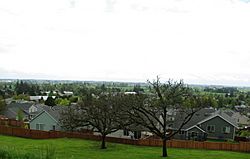Dundee, Oregon facts for kids
Quick facts for kids
Dundee, Oregon
|
|
|---|---|

Overlooking the city
|
|

Location in Oregon
|
|
| Country | United States |
| State | Oregon |
| County | Yamhill |
| Incorporated | 1895 |
| Area | |
| • Total | 1.36 sq mi (3.53 km2) |
| • Land | 1.34 sq mi (3.47 km2) |
| • Water | 0.02 sq mi (0.06 km2) |
| Elevation | 187 ft (57 m) |
| Population
(2020)
|
|
| • Total | 3,238 |
| • Density | 2,418.22/sq mi (933.79/km2) |
| Time zone | UTC-8 (Pacific) |
| • Summer (DST) | UTC-7 (Pacific) |
| ZIP code |
97115
|
| Area code(s) | 503 |
| FIPS code | 41-21050 |
| GNIS feature ID | 2410370 |
| Website | www.dundeecity.org |
Dundee /ˈdʌndiː/ is a city in Yamhill County, Oregon, United States. The population was 3,238 at the 2020 census.
Contents
History
Dundee was named after Dundee, Scotland, the birthplace of William Reid. Reid came to Oregon in 1874 to establish the Oregonian Railway, and made several extensions to the railroad in the western Willamette Valley.
The first post office in the area, established in 1881, was called Ekins. The Ekins post office was closed in 1885, and in 1887 a new office opened and was named "Dundee Junction." The name was chosen in anticipation of plans to build a bridge across the Willamette River for the railroad, which would have called for a junction at Dundee between the west railroad and the new east railroad. The bridge was never built, however, and the post office was renamed "Dundee" in 1897.
In 1913, the Dundee Woman's Club was founded and later established a community center.
Geography
According to the United States Census Bureau, the city has a total area of 1.35 square miles (3.50 km2), of which 1.33 square miles (3.44 km2) is land and 0.02 square miles (0.05 km2) is water.
Dundee is two miles southwest of the city of Newberg.
Demographics
| Historical population | |||
|---|---|---|---|
| Census | Pop. | %± | |
| 1900 | 124 | — | |
| 1910 | 196 | 58.1% | |
| 1920 | 193 | −1.5% | |
| 1930 | 232 | 20.2% | |
| 1940 | 209 | −9.9% | |
| 1950 | 308 | 47.4% | |
| 1960 | 318 | 3.2% | |
| 1970 | 588 | 84.9% | |
| 1980 | 1,223 | 108.0% | |
| 1990 | 1,663 | 36.0% | |
| 2000 | 2,598 | 56.2% | |
| 2010 | 3,162 | 21.7% | |
| 2020 | 3,238 | 2.4% | |
| U.S. Decennial Census | |||
2010 census
As of the census of 2010, there were 3,162 people, 1,136 households, and 866 families living in the city. The population density was 2,377.4 inhabitants per square mile (917.9/km2). There were 1,175 housing units at an average density of 883.5 per square mile (341.1/km2). The racial makeup of the city was 91.2% White, 0.4% African American, 1.2% Native American, 1.4% Asian, 0.2% Pacific Islander, 3.1% from other races, and 2.6% from two or more races. Hispanic or Latino of any race were 10.4% of the population.
There were 1,136 households, of which 41.1% had children under the age of 18 living with them, 62.4% were married couples living together, 8.9% had a female householder with no husband present, 4.9% had a male householder with no wife present, and 23.8% were non-families. 19.3% of all households were made up of individuals, and 8% had someone living alone who was 65 years of age or older. The average household size was 2.78 and the average family size was 3.15.
The median age in the city was 36.7 years. 27.8% of residents were under the age of 18; 6.7% were between the ages of 18 and 24; 29.3% were from 25 to 44; 26.1% were from 45 to 64; and 10.2% were 65 years of age or older. The gender makeup of the city was 50.3% male and 49.7% female.
See also
 In Spanish: Dundee (Oregón) para niños
In Spanish: Dundee (Oregón) para niños

